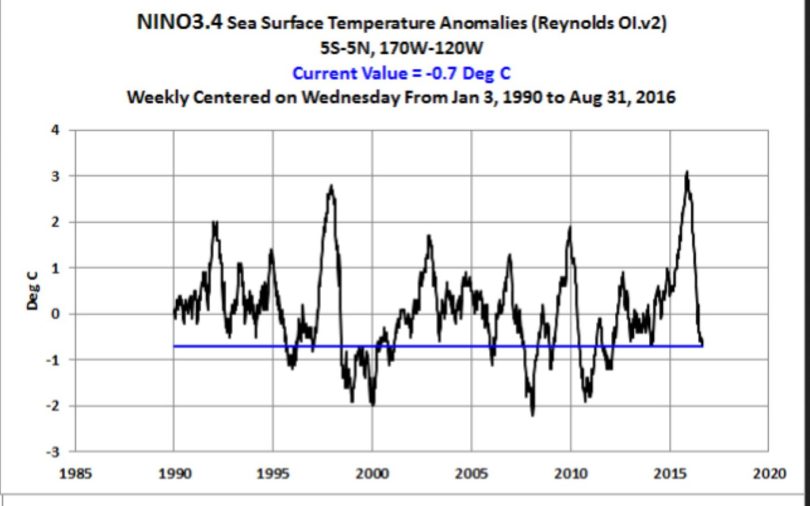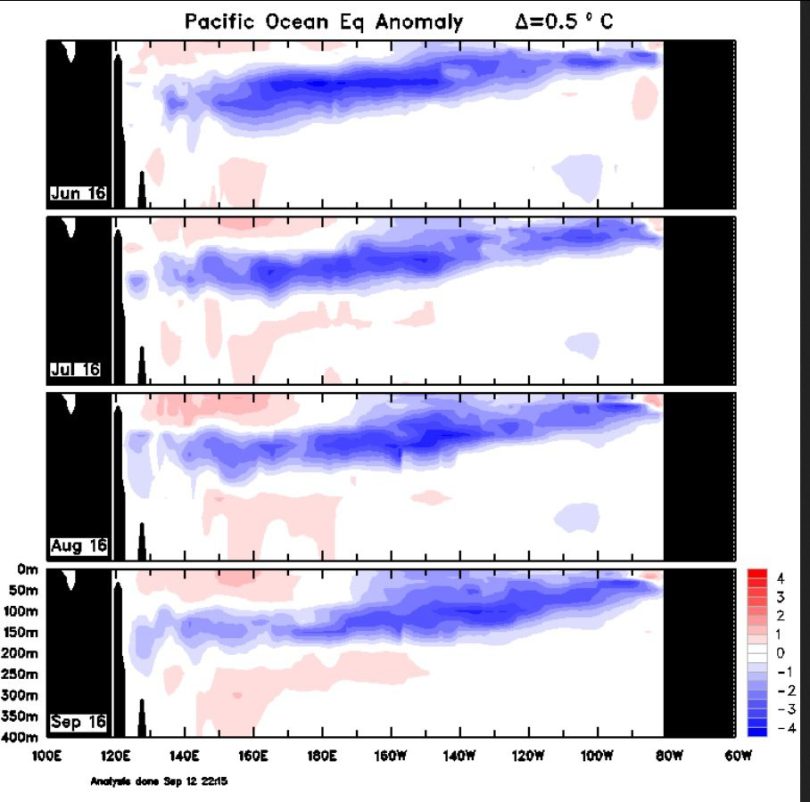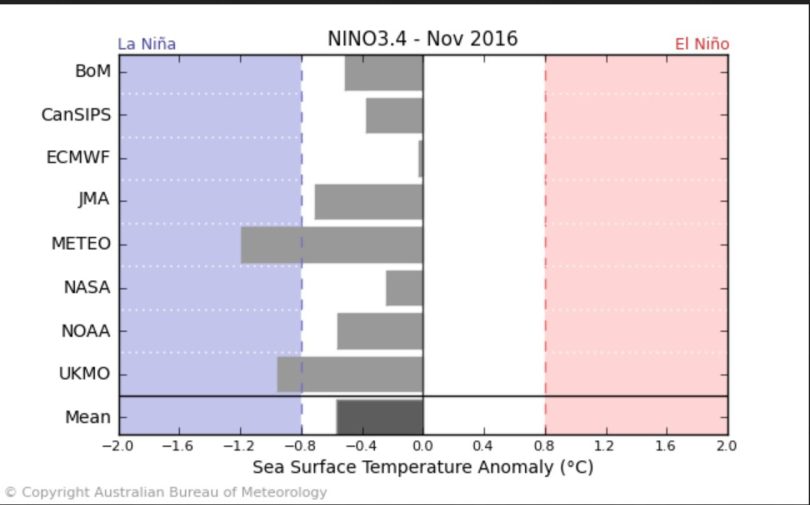German climate and weather analyst Schneefan here Looks at the current ENSO conditions. What follows are excerpts of what he presents.
===================================
The global cooling weather phenomenon La Niña in the equatorial Pacific is steadily increasing in strength – and the NOAA has not recognized this: NOAA Cancels La Niña Watch While La Niña Conditions Exist.
The NOAA has even removed its “La Niña-Watch” last week from its ENSO weekly reports even though the sea surface temperature anomalies (SSTA) in the main Niño-area 3.4 around August 31 had -0.7 K.
The plot SSTA in the Niño area from 1990 to early September 2016. The end of August/early September 2016 was clearly in the La Niña range at a value of -0.7 and thus has plummeted by more than 3°C since March. Source: NOAA Cancels La Niña Watch While La Niña Conditions Exist
The Southern Oscillation Index (SOI) is considered as the two-month leading indicator for the development of the easterly trade winds at the equatorial Pacific, and thus for the development of the ENSO. The 30-day index shows the difference between the surface atmospheric pressure between Tahiti and Darwin (Australia).
Currently it’s at +10.6 and thus clearly in the La Niña range of over +7 and rising steeply:
30-day SOI of the Australian BOM weather office over the pastz 2 years. Mid September 2016 the value was 10.6, well into La Niña range. That’s the highest level in over two years: La Niña is here and will be around for awhile. Source: www.bom.gov.au/climate/enso/
The warm surface water of the Pacific is driven westwards topwards Australia, and thus bringing cooler water from the depths to the sea surface: Cold upwelling is created and leads to the La Niña.
The SOI shows a clear La Niña path for at least the coming two months.
The cold upwelling phase can also be seen (at least by most of us) through the measured/calculated subsurface temperatures down to 300m depth at the equatorial Pacific:
Plot shows the temperature anomalies underwater at the equatorial Pacific from June to September 12, 2016. Cold dominates a large region: La Niña is there – and will remain. Source: 4-month sequence of Pacific Ocean equatorial temperature anomaly cross sections.
Despite these clear indications in both the atmosphere and in the water at the equatorial Pacific region, the ENSO models remain completely in dispute over the development up to November.
The model from METEO foresees strong La Niña conditions of -1.2 K, but the ECMWF sees almost neutral condtions. Source: www.bom.gov.au/Pacific-Ocean
Arctic Sea Ice Rebounds
Meanwhile Japanese climate blogger Kirye here keeps us up to date on Arctic sea ice, which missed setting a record low this year by a long shot. Kirye presents the following DMI interactive chart:

And if one looks at the area trend over the past 10 years, there has been no decline at all. Moreover a large region of Arctic sea ice is now quite thick – far from being disappeared. Compare today’s Arctic sea thickness to that of 2008, for example.
Currently the ice area is well over 4 Wadhams (1 million sq kilometers) thick. (One reader suggested using “Wadhams” as a unit for sea ice area in order to honor Peter Wadhams’s spectacularly failed prediction of an ice free Arctic by now.)









[…] Arctic Ice Stabilized Over Past 10 Years […]
[…] Arctic Ice Stabilized Over Past 10 Years – Sea Surface Temps Plummet 3°C With Aproaching La Niña […]
Question for everyone: Are there not several different regions of the Pacific which are watched for el-nino or la-nina conditions? I’m just curious why NASA would drop the la-nina watch when it is clear things are pointing ever more heavily in that direction (and one has to wonder: WHY? When a rough winter descends on regions that were counting on it NOT happening Re: NASA…..)
You can read all about it here:
ENSO-neutral conditions are slightly favored (between 55-60%) during the upcoming Northern Hemisphere fall and winter 2016-17.
http://www.cpc.ncep.noaa.gov/products/analysis_monitoring/lanina/enso_evolution-status-fcsts-web.pdf
And:
Most multi-model averages indicate a borderline or a weak
La Niña starting during the Northern Hemisphere fall and persisting through winter 2016-17. [ from page 24 ]
Other agencies do watch different things, so borderline and slightly seem to be the current outlook based on what NOAA looks at.
Hi Paul, Thank you for adopting the unit “1 Wadham = 1 million km²” of sea ice.
I hope we can push this to spread to all forums and eventual total acceptance. 🙂
Look on Google Earth under “Ruler.”
Click there to see the available length units.
Last in the list is Smoots.
After Oliver R. Smoot.
ps According to sunshine hours current 2016 sea ice area is almost exactly 1 Wadham above 2012. 🙂
“The warm surface water of the Pacific is driven westwards towards Australia”
Thanks, as if we aren’t already having enough rain down here !!”
“Currently the ice area is well over 4 Wadhams (1 million sq kilometers) thick.”
This sentence does not make any sense.
“And if one looks at the area trend over the past 10 years, there has been no decline at all.”
Cherrypick the dataset and cherrypick the time range and you do not even get a massive increase? deplorable, i say!
The last ten years, is the most recent period. It tells what is happening most recently.
Yes there was a decline in Arctic sea ice levels from the EXTREME levels of the 1979 cold period (well documented)
But the AMO has now topped out for the last 10 years, and the Arctic sea ice levels have levelled offf in response.
Only a total idiot takes the downward leg of a cycle and thinks it will continue as a linear trend.
““Currently the ice area is well over 4 Wadhams (1 million sq kilometers) thick.””
Yep, should read
“Currently the ice area is well over 4 Wadhams (1 million sq kilometers) in area.”
Did you know, the current sea ice area is almost exactly 1 Wadham more than the same time time in 2012.
oh, and in case anyone is interested in any facts: this tiny yacht passed both, the NW and the NE passage in a single summer.
http://www.bbc.com/news/science-environment-37351271
The sea ice must have been extremely thick!
“The sea ice must have been extremely thick!”
Nowhere near as thick as your head, caitie.
Anyone interested in facts doesn’t bother with the PC Warmunista blockheads at the BBC anymore.
https://bbcwatch.org/
http://www.heliogenic.net/2010/02/02/the-bbcs-enviro-extremist-agenda-not-limited-to-global-warming-hysteria/
http://biasedbbc.org/
Why would you attack the BBC for reporting facts?
you can also read the ship log, of course.
http://polarocean.co.uk/its-over-were-in-upernavik/
Your attacks on the BBC are incredible, as are those pages. Just unbelievable!
One ship making it through is not a “proof” of anything. Improved technology combined with slightly warmer climate (though NOT because of human activity) is making it possible, and has for some time now.
http://www.enr.gov.nt.ca/state-environment/73-trends-shipping-northwest-passage-and-beaufort-sea
It’s not a bad thing, either, if the world is a bit warmer, because as we’ve discussed in the past, there will be fewer people dying from cold. Anyone who wants a cooler world, wants more people to die.
Now, back to the BBC…
BBC IS GARBAGE
Lies about the “experts” they consulted, and then refused to tell who they were, but were found out to be activists, and NONE were among the who’s who of British scientific experts.
http://www.thinkscotland.org/thinkpolitics/articles.html?read_full=11776
The $ource of their bia$.
http://www.express.co.uk/news/uk/156703/8bn-BBC-eco-bias
Stinkers all.
https://australianclimatemadness.com/2011/04/03/bbc-left-wing-shallow-and-oh-so-politically-correct/
And just because the BBC reports on some fool who happens to make it through the passage in summer, SO WHAT?! Many try. Few succeed. Just because you are impressed with random noise doesn’t mean we have to be.
“Why would you attack the BBC for reporting facts?” – sod the credulous
It’s not the few facts they report that I have a problem with, it’s the many many lies, as well as the spin they put on the few facts they report.
I guess their lies about the queen were just in fun, eh?
http://www.adweek.com/fishbowlny/bbc-lied-about-the-queen-will-heads-roll/113848
Useless rag.
Here’s a partial list of those who’ve made the trip before
https://notalotofpeopleknowthat.wordpress.com/2016/09/16/a-list-of-the-full-transits-of-the-northwest-passage/
The sea ice through Vilkitsky Strait/Laptev Sea was very thick.
There were two Ice Breakers helping commercial shipping through.
Hard to follow an ice breaker in a small boat though, too much moving slabs of ice.
They did try once, but realised the folly and returned to wait for the southerly storm forecasted on their satellite maps to hopefully open a route close to shore. Which luckily for them, it did.
Christopher Booker shreds the ultra gullible sod/caitie to pieces…
https://notalotofpeopleknowthat.wordpress.com/2016/09/18/the-bbcs-intrepid-arctic-explorer-follows-in-his-own-footsteps/
“…far from these people being the first ever to sail in a yacht through both the North West and North East Passages, Nikolai Litau himself – as revealed by Paul Homewood on his Notalotofpeopleknowthat website – not only made both those journeys between 1996 and 2002; he took in the Antarctic as well. But we didn’t hear about that from the BBC. It wouldn’t have fitted their ‘narrative’.”
(If that’s the info sob is accusing Breitbart of “making up,” then sob is the “denier.”)
https://notalotofpeopleknowthat.wordpress.com/2016/09/14/northabouts-skippers-earlier-trips-through-the-impassable-ne-nw-passages/
Yes, the sea ice was VERY thick in the Vilkitsky/Laptev sea regions. They got lucky and a storm blew the ice away from shore for a day or so and they managed to sneak through
And in the NW Passage, they used the very most southern route through Cambridge bay, (except through Fury/Hecla which was impassable at the time).
The Main NW Passage was blocked with heavy sea ice
The 1944 Larsen route was blocked with heavy sea ice
Even Amundsen’s 1903 route was blocked by sea ice.
It was only satellite weather charts that allowed them to position themselves on the coast ready to sneak through Vilkitsky if the ice cleared enough.
Satellite sea ice charts also showed them that they had to run flat chat on the fossil fuel engine, and skip a couple of layovers if they were to beat the sea ice in Lawrence Sound. With the speeds they were registering out through Bellot straight I suspect they had both outboard motors humming along too.
The little boat has not proven anything except that modern satellite technology makes it so much easier when you know where the sea ice will be, and not be, well in advance.
A big diesel with 2000 litres storage and 2500 mile range. Not so little either at 49 feet and purpose built for polar work. They have two 15hp two stroke (naughty!) outboards for the inflatables, a generator, etc. etc. Sea ice chart link has been taken down, there’s a surprise.
It looks like “Breitbart “””News””” might possibly not be the best source of information. They were still making fun of the “suip of fools” some weeks ago.
http://www.breitbart.com/london/2016/09/01/green-arctic-expedition-frustrated-large-quantities-ice/
Sea ice is sooo thick, that a 24 year old and his hen can run the passage in a 10 m boat.
http://www.pbo.co.uk/news/french-skipper-pet-hen-northwest-passage-43271
But hey, why< bother with facts? Breitbart is already making up stories about how easy this was in the past. So just jump to the next explanation of the facts contradicting your opinion…
Why is it that reporting the facts makes them “unreliable?”
They were in serious danger. Just because those fools made it through doesn’t retroactively mean the ice they ran into, and could have killed them, wasn’t real.
Also, show me the link to Breitbard “making up stories about how easy this (?) was in the past.” Or are you just making up stories about Breitbart?
current sea ice extent
http://ocean.dmi.dk/arctic/plots/icecover/osisaf_nh_iceextent_daily_5years_en.png
Oh, yeah. NOW I see the problem. sod shot first and aimed later, as usual.
Love the Wadhams….poor man, diddums!
‘sod’ says “this tiny yacht”
The aspect of an ice free arctic ocean that causes shipping types to cheer is that an actual freight-carrying vessel can pass safely and regularly.
They look like this:
https://en.wikipedia.org/wiki/Bulk_carrier#/media/File:Sabrina_I_cropped.jpg
The series of photos is instructive. Container ships differ but are as big or bigger.
While a “tiny yacht” may make many and quick course changes, and thus pass through iceberg enhanced water, bulk carriers and container ships will likely not try to do so.
As for the alarmists cheering a less than Wadhams Arctic Ocean, I have not been convinced that such a thing for a day, a week, or a month would be an Earth destroying calamity. Maybe the escape of ocean stored energy (heat to atmosphere) could trigger a year or 2 or 3 cold period. I think that is a “maybe” but would not expect it to last.
90hp Perkins diesel and 2000 litre storage giving 2500 mile range (about 15 – 20 days continuous use) on a 49 foot purpose built and ice strengthened yacht. That’s a big engine for a sailing boat of that size. They refilled the diesel tanks at least once enroute. Franklin’s HMS Terror was just over twice as long and had a 25hp steam engine with coal for only 7 days use.
Yep, it will all melt really soon….
https://www.windyty.com/?temp,2016-01-13-03,79.997,-14.194,2
Oops, lets try the correct date —
https://www.windyty.com/?temp,79.997,-14.194,2
And an alternative view of the current situation is shown at —
https://earth.nullschool.net/#current/wind/surface/level/overlay=temp/orthographic=-1.49,77.15,256/loc=-22.933,89.635
Based on how slowly ice refroze in Sept. 2007, I think it likely 2016 will have a higher monthly average.
https://rclutz.wordpress.com/2016/09/17/arctic-plateau-continues/
Just a minor correction…
“(One reader suggested using “Wadhams” as a unit for sea ice area in order to honor Peter Wadhams’s spectacularly failed prediction of an ice free Arctic by now.)”
should be…
(One reader suggested using “Wadhams” as a unit for sea ice area in order to honor Peter Wadhams’s spectacularly failed MULTIPLE predictionS of an ice free Arctic by now.)
There, fixed it for you… 😀
[…] 7) Arctic Ice Stabilizes As Sea Surface Temps Plummet 3°C No Tricks Zone, 17 September 2016 […]